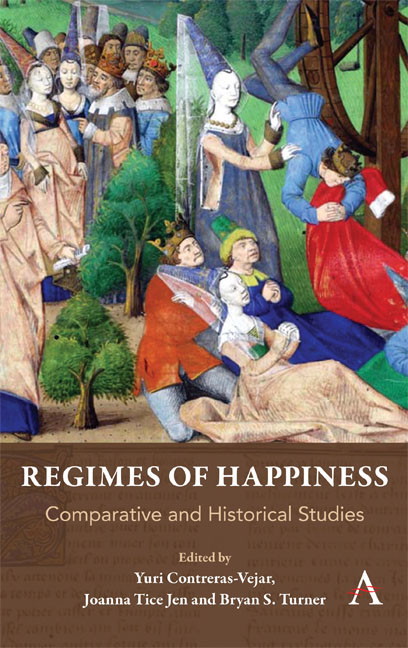Book contents
- Frontmatter
- Contents
- Acknowledgements
- Notes on Contributors
- Introduction: Reflections on Regimes of Happiness
- Part I Happiness in the West
- Chapter One A Fragment of Bliss: Augustinian Beatitudo and the Ideal of Atonement
- Chapter Two Arts of Happiness and Love: Translating Aristotle in the Later Middle Ages
- Chapter Three Spiritual Transcendence as the Path to Happiness in a Selection of Old French Texts
- Chapter Four On Machiavelli, St. Francis and the Pursuit of Happiness
- Chapter Five Their Idea of Happiness Prevents Easy Categorization of Scottish Enlightenment Philosophers
- Chapter Six A Path to Eternal Happiness: Convent Life in the United States in the Nineteenth Century
- Chapter Seven “Be Joyful Always!”: Twenty-First-Century Evangelical Conceptions of Happiness and Trumpist Politics
- Chapter Eight The Erasmus Program: The Promise of European Happiness
- Chapter Nine Innovations in the Psychological Study of Happiness: From Mirror Neurons to Mobile Technology
- Part II Comparative Perspectives
- Index
Chapter Eight - The Erasmus Program: The Promise of European Happiness
from Part I - Happiness in the West
Published online by Cambridge University Press: 29 May 2019
- Frontmatter
- Contents
- Acknowledgements
- Notes on Contributors
- Introduction: Reflections on Regimes of Happiness
- Part I Happiness in the West
- Chapter One A Fragment of Bliss: Augustinian Beatitudo and the Ideal of Atonement
- Chapter Two Arts of Happiness and Love: Translating Aristotle in the Later Middle Ages
- Chapter Three Spiritual Transcendence as the Path to Happiness in a Selection of Old French Texts
- Chapter Four On Machiavelli, St. Francis and the Pursuit of Happiness
- Chapter Five Their Idea of Happiness Prevents Easy Categorization of Scottish Enlightenment Philosophers
- Chapter Six A Path to Eternal Happiness: Convent Life in the United States in the Nineteenth Century
- Chapter Seven “Be Joyful Always!”: Twenty-First-Century Evangelical Conceptions of Happiness and Trumpist Politics
- Chapter Eight The Erasmus Program: The Promise of European Happiness
- Chapter Nine Innovations in the Psychological Study of Happiness: From Mirror Neurons to Mobile Technology
- Part II Comparative Perspectives
- Index
Summary
Introduction
The question which must be resolved first, failing which progress is no more than mere appearance, is the definitive abolition of the division of Europe into national, sovereign States.
Ventotene Manifesto 1943The Community shall have as its task, by establishing a common market and progressively approximating the economic policies of Member States, to promote throughout the Community a harmonious development of economic activities, a continuous and balanced expansion, an increase in stability, an accelerated raising of the standard of living and closer relations between the States belonging to it.
Article 2, Treaty of Rome 1957The Union's aim is to promote peace, its values and the well- being of its peoples.
Article 3, Consolidated version of the Treaty on European Union 2009Unlike the famous American declaration, happiness does not appear in the founding texts of the European Union. Nevertheless, a firm belief and willingness to achieve the “well- being” and “closer relation” among European states, at least in words, seem to be at the core of the whole process of European integration: the real alternative to the national state, deemed as the historical culprit of war and division among Europeans.
Over the past few years this process has stopped: Brexit, the rise of anti- euro, nationalpopulist political parties and fears over immigration in both Eastern and Western Europe are the most acute and recent symptoms of the ongoing struggle the EU is facing.
What happened to the seeming irresistible process of a closer European Union? What about its mission to bring people together and to foster their well- being? This is a broad multifaceted question without an easy answer. However, looking at the image of success and happiness the EU has constructed and fostered over time may provide us hints on its inner contradictions and problems.
To do so, I plan to use as a case study one of EU's most successful initiatives: the Erasmus program, a student exchange project that allowed three million young European university students to study abroad in other EU member states. Erasmus has been defined as “Europe's last hope” (Makowski 2012), the “new sexual European revolution” (Riotta 2014), and even as “Erasmus- Orgasmus” (MacGregor 2012) responsible for the birth of one million babies from couples of mixed nationalities (AFP 2014).
- Type
- Chapter
- Information
- Regimes of HappinessComparative and Historical Studies, pp. 111 - 130Publisher: Anthem PressPrint publication year: 2019

